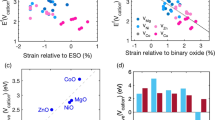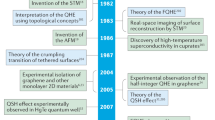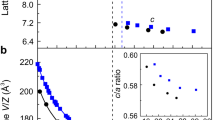Abstract
Phase-change materials are of tremendous technological importance ranging from optical data storage to electronic memories. Despite this interest, many fundamental properties of phase-change materials, such as the role of vacancies, remain poorly understood. ‘GeSbTe’-based phase-change materials contain vacancy concentrations around 10% in their metastable crystalline structure. By using density-functional theory, the origin of these vacancies has been clarified and we show that the most stable crystalline phases with rocksalt-like structures are characterized by large vacancy concentrations and local distortions. The ease by which vacancies are formed is explained by the need to annihilate energetically unfavourable antibonding Ge–Te and Sb–Te interactions in the highest occupied bands. Understanding how the interplay between vacancies and local distortions lowers the total energy helps to design novel phase-change materials as evidenced by new experimental data.
This is a preview of subscription content, access via your institution
Access options
Subscribe to this journal
Receive 12 print issues and online access
$259.00 per year
only $21.58 per issue
Buy this article
- Purchase on Springer Link
- Instant access to full article PDF
Prices may be subject to local taxes which are calculated during checkout






Similar content being viewed by others
References
El-Mellouhi, F., Mousseau, N. & Ordejon, P. Sampling the diffusion paths of a neutral vacancy in silicon with quantum mechanical calculations. Phys. Rev. B 70, 205202 (2004).
Yamada, N. Erasable phase-change optical materials. Mater. Res. Soc. Bull. 21, 48–50 (1996).
Ovshinsky, S. R. Reversible electrical switching phenomena in disordered structures. Phys. Rev. Lett. 21, 1450–1453 (1968).
Wuttig, M. Phase-change materials—towards a universal memory? Nature Mater. 4, 265–266 (2005).
Lankhorst, M., Ketelaars, B. & Wolters, R. Low-cost and nanoscale non-volatile memory concept for future silicon chips. Nature Mater. 4, 347–352 (2005).
Kolobov, A. et al. Understanding the phase-change mechanism of rewritable optical media. Nature Mater. 3, 703–708 (2004).
Wełnic, W. et al. Unraveling the interplay of local structure and physical properties in phase-change materials. Nature Mater. 5, 56–62 (2006).
Matsunaga, T. & Yamada, N. Structural investigation of Ge1Sb2Te4: A high-speed phase-change material. Phys. Rev. B 69, 104111 (2004).
Kooi, B., Groot, W. & de Hosson, J. In situ transmission electron microscopy study of the crystallization of Ge2Sb2Te5 . J. Appl. Phys. 95, 924–932 (2004).
Abrikosov, N. & Danilova-Dobryakova, G. Study of the SbTe–GeTe phase diagram. Izv. Akad. Nauk. SSSR, Neorg. Mater. 1, 204–209 (1965).
Matsunaga, T., Kubota, Y. & Yamada, N. Structures of stable and metastable Ge2Sb2Te5, an intermetallic compound in the GeTe–Sb2Te3 pseudobinary systems. Acta Crystallogr. B 60, 685–691 (2004).
Matsunaga, T. & Yamada, N. A study of highly symmetrical crystal structures, commonly seen in high speed phase change materials, using synchrotron radiation. Jpn J. Appl. Phys. 41, 1674–1678 (2002).
Edwards, A. H. et al. Electronic structure of intrinsic defects in crystalline germanium telluride. Phys. Rev. B 73, 045210 (2006).
Adler, D., Shur, M. & Ovshinsky, S. Threshold switching in chalcogenide-glass thin films. J. Appl. Phys. 51, 3289–3309 (1980).
Pirovano, A., Lacaita, A., Benvenuti, A., Pellizzer, F. & Bez, R. Electronic switching in phase-change memories. IEEE Trans. Electron Devices 51, 452–459 (2004).
Baranovskii, S. & Karpov, V. Localized electron states in glassy semiconductors (review). Sov. Phys. Semicond. 21, 1–10 (1987).
Matsunaga, T. et al. Single structure widely distributed in a GeTe–Sb2Te3 pseudobinary system: A rocksalt structure is retained by intrinsically containing an enormous number of vacancies within its crystal. Inorg. Chem. 45, 2235–2241 (2006).
Shamoto, S. et al. Large displacement of germanium atoms in crystalline Ge2Sb2Te5 . Appl. Phys. Lett. 86, 081904 (2005).
Glassey, W., Papoian, G. & Hoffmann, R. Total energy partitioning within a one-electron formalism: A Hamilton population study of surface-co interaction in the c(2×2)-CO/Ni (100) chemisorption system. J. Chem. Phys. 111, 893–910 (1999).
Pearson, R. Absolute electronegativity and hardness: Application to inorganic chemistry. Inorg. Chem. 27, 734–740 (1988).
Gaspard, J.-P. & Ceolin, R. Hume-Rothery rule in V–VI compounds. Solid State Commun. 84, 839–842 (1992).
Peierls, R. Quantum Theory of Solids (Oxford Univ. Press, Oxford, 1956).
Gaspard, J.-P., Pellegatti, A., Marinelli, F. & Bichara, C. Peierls instabilities in covalent structures I. Electronic structure, cohesion and the Z=8−N rule. Phil. Mag. B 77, 727–744 (1998).
Burdett, J. K. & McLarnan, T. J. A study of the arsenic, black phosphorus, and other structures derived from rock salt by bond-breaking processes. I. Structural enumeration. J. Chem. Phys. 75, 5764–5773 (1981).
Burdett, J. K., Haaland, P. & McLarnan, T. J. A study of the arsenic, black phosphorus, and other structures derived from rock salt by bond-breaking processes. II. Band structure calculations and the importance of the gauche effect. J. Chem. Phys. 75, 5774–5781 (1981).
Burdett, J. K. Chemical Bonds—A Dialog (Wiley, New York, 1997).
Miller, G. J. & Verkade, J. G. A pictorial approach to molecular orbital bonding in polymers: Non-mathematical but honest. J. Chem. Educ. 76, 428–433 (1999).
Decker, A., Landrum, G. & Dronskowski, R. Structural and electronic peierls distortions in the elements (A): The crystal structure of tellurium. Z. Anorg. Allg. Chem. 628, 295–302 (2002).
Kastner, M. Bonding bands, lone-pair bands, and impurity states in chalcogenide semiconductors. Phys. Rev. Lett. 28, 355–357 (1972).
Gonzalez-Hernandez, J., Chao, B., Ovshinsky, S., Pawlik, D. & Gasiorowski, P. Crystallization studies of Ge:Sb:Te optical memory materials. Appl. Phys. Commun. 11, 557–581 (1992).
Lankhorst, M. Modelling glass transition temperatures of chalcogenide glasses. Applied to phase change optical recording materials. J. Non-Cryst. Solids 297, 210–219 (202).
Zhou, G. Material aspects in phase change optical recording. Mater. Sci. Eng. A 304–306, 73–80 (2001).
Borg, H., Lankhorst, M., Meinders, E. & Leibbrandt, W. Phase change media for high density optical recording. Mater. Res. Soc. Symp. Proc. 674, V1.2.1–10 (2001).
Wuttig, M. et al. The quest for fast phase change materials. Mater. Res. Soc. Symp. Proc. 674, V1.8–16 (2001).
Gonze, X. et al. First-principles computation of material properties: the ABINIT software project. Comput. Mater. Sci. 25, 478–492 (2002).
Goedecker, S. Fast radix 2, 3, 4 and 5 kernels for fast Fourier transformations on computers with overlapping multiply-add instructions. SIAM J. Sci. Comput. 18, 1605 (1997).
Payne, M. C., Teter, M. P., Allan, D. C., Arias, T. A. & Joannopoulos, J. D. Iterative minimization techniques for ab initio total-energy calculations: molecular dynamics and conjugate gradients. Rev. Mod. Phys. 64, 1045–1097 (1992).
Gonze, X. Towards a potential-based conjugate gradient algorithm for order-N self-consistent total energy calculations. Phys. Rev. B 54, 4383–4386 (1996).
Fuchs, M. & Scheffler, M. Ab initio pseudopotentials for electronic structure calculations of poly-atomic systems using density-functional theory. Comput. Phys. Commun. 119, 67–98 (1999).
Hamann, D. Generalized norm-conserving pseudopotentials. Phys. Rev. B 40, 2980–2987 (1989).
Perdew, J. P., Burke, K. & Ernzerhof, M. Generalized gradient approximation made simple. Phys. Rev. Lett. 77, 3865–3868 (1996).
Andersen, O. K. Linear methods in band theory. Phys. Rev. B 12, 3060–3083 (1975).
Skriver, H. The LMTO Method (Springer, Berlin, 1984).
Andersen, O. The Electronic Structure of Complex Systems (Plenum, New York, 1984).
Andersen, O. K. & Jepsen, O. Explicit, first-principles tight-binding theory. Phys. Rev. Lett. 53, 2571–2574 (1984).
Koringa, J. On the calculation of the energy of a bloch wave in a metal. Physica 13, 392–400 (1947).
Kohn, W. & Rostoker, N. Solution of the Schrödinger equation in periodic lattices with an application to metallic lithium. Phys. Rev. 94, 1111–1120 (1954).
von Barth, U. & Hedin, L. A local exchange-correlation potential for the spin polarized case. i. J. Phys. C: Solid State Phys. 5, 1629–1642 (1972).
Hoffmann, R. Solids and Surfaces: A Chemist’s View of Bonding in Extended Structures (VCH, Weinheim, 1988).
Dronskowski, R. Computational Chemistry of Solid State Materials (VCH, Weinheim, 2005).
Acknowledgements
We gratefully acknowledge support from the Deutsche Forschungsgemenischaft (Wu 243/11). We thank J. Neugebauer for fruitful discussions, Umicore (Liechtenstein) for the careful preparation of phase-change targets and M. Heidelmann for carrying out the static tester measurements. Furthermore, we thank the Rechenzentrum of the RWTH Aachen for providing computer time and technical support.
Author information
Authors and Affiliations
Contributions
D.L. carried out the plane-wave pseudopotential calculations (structural relaxation, formation energies); M.G. carried out the calculations for the quantum-chemical bonding analysis (COHP); D.W. carried out the experiments (XRD, ellipsometry, Kissinger analysis, recrystallization behaviour); M.W. initialized this research project and M.W., W.W. and R.D. carried out the analysis of the data.
Corresponding author
Ethics declarations
Competing interests
The authors declare no competing financial interests.
Supplementary information
Supplementary Information
Supplementary information (PDF 68 kb)
Rights and permissions
About this article
Cite this article
Wuttig, M., Lüsebrink, D., Wamwangi, D. et al. The role of vacancies and local distortions in the design of new phase-change materials. Nature Mater 6, 122–128 (2007). https://doi.org/10.1038/nmat1807
Received:
Accepted:
Published:
Issue Date:
DOI: https://doi.org/10.1038/nmat1807
This article is cited by
-
Structural Transformation of Thin Ge2Sb2Te5
Films Produced by Ion-Plasma Co-Sputtering Under Laser Irradiation Journal of Electronic Materials (2023)
-
Hypervalency in amorphous chalcogenides
Nature Communications (2022)
-
The “gene” of reversible phase transformation of phase change materials: Octahedral motif
Nano Research (2022)
-
Field-like spin–orbit torque induced by bulk Rashba channels in GeTe/NiFe bilayers
NPG Asia Materials (2021)
-
Phase-enabled metal-organic framework homojunction for highly selective CO2 photoreduction
Nature Communications (2021)



